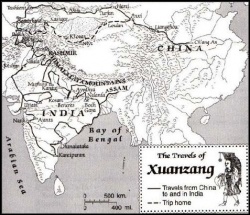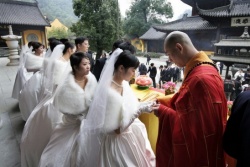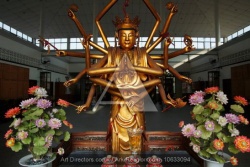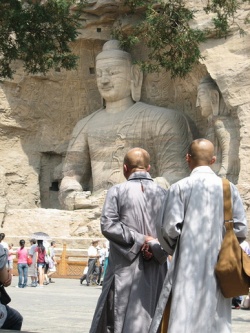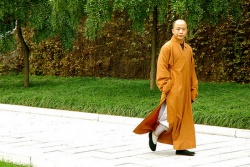History of Buddhism in China
by Jeffrey Hays
Buddhism entered China, perhaps as early as the first century B.C., from India via the Silk Road trade route and Central Asia, where goods were traded between China and the Roman Empire and cultures from China merged with those of India, Central Asia and Iran. Artifacts from Kushan--a Greek-influenced, Pakistan-based, Buddhist civilization--have been found in western China.
In the A.D. 1st century Buddhism caught they eye of the Han Emperor Ming, who sent a mission to India which returned in A.D. 67 with Buddhist scriptures, two Indian monks and several Buddhist images. By the end of the A.D. 1st century there was a Buddhist community in the Chinese capital of Loyang.
Buddhism though didn’t really begin to have an influence on China until the A.D. 2nd century, when Buddhist monks and translator-missionaries from India and Central Asia began arriving in larger numbers overland along the Silk Road and by sea on trade routes between India and China via Southeast Asia.
The first Buddhist monks arrived with shaven heads, begging bowls and robes at a time when the only people in China that dressed and acted in such a manner were criminals and beggars. These monks, traveling alone and in pairs, had nether homes nor families—concepts that defied traditional Confucian emphasis on family, honoring ancestors and producing heirs. The earliest Buddhist monasteries in China were run primarily by Chinese-speaking Indians and Central Asians. As their Chinese students matured Chinese took over the monasteries and Buddhist texts translated to Chinese became the main texts.
Buddhism arrived in China at roughly the same time Christianity was spreading from Palestine into the Roman Empire. Unlike Christianity in Europe, Buddhism in China was never able to wipe out traditional moral and religious beliefs that existed before it. At first Buddhism was viewed as just another Taoist sect. Stories circulated that the Taoist founder Lao-tze emigrated to the West and became a teacher of The Buddha or became The Buddha himself.
Spread of Buddhism in China
Buddhism developed and spread rapidly in the chaos of the Six Dynasties Period (A.D. 220-589) that followed the collapse of the Han dynasty in A.D. 220. The seeking of nirvana and peace and other Buddhist doctrines seemed like nice ideas at a time when China was a violent and dangerous place.
Interest in Buddhism also grew as Silk Road trade stimulated an interest in exotic things and monk-sponsored welfare projects attracted devotees from many social strata. At times Buddhism prospered under imperial patronage. At times its foreign origin led it to be singled out for major persecutions.
By the A.D. 3rd century the Chinese monk community had become consolidated and Buddhist missionaries began moving around China. By and large they were welcomed. Buddhism caught on most quickly in northern China, where the belief was patronized by a number of rulers, and spread southward with the migration of Han Chinese.
During the 4th century, when China was engulfed in war and the northern areas were overrun by horsemen from Mongolia, Buddhism was the dominant faith in China. By that time Buddhist missionaries had not only spread their religion to the far corners of China they had also made inroads into imperial court in Nanking.
By the 5th century Buddhism was well patronized in many Chinese state;, sutras in Chinese were widely circulated; and their meanings were debated, giving rise to the first schools. The earliest-surviving Buddhist art from China—in cave shrines in Xinjiang and Yunkang near the Great Wall—date from this period. By medieval times the Sanga system of patronage—where the rich helped the monasteries and the monasteries helped educate the masses—was firmly entrenched.
Buddhism Takes on a Chinese Character
Chinese Buddhism retained all the elements of the Buddhism that arrived India: the monastic system, the rites of worship, the sacred writings and the contemplative exercises. Beliefs about reincarnation are believed to have been one major reason why Buddhism found such a receptive audience in China. These beliefs gave a structure and coherence to traditional beliefs about transmigration.
Buddhism also underwent some changes in China. Early Chinese Buddhism featured elements—such as rituals in which family members could perform good deeds and pass the merit they earned on to tormented ancestors—that were designed specifically to appeal to Chinese.
Buddhism was absorbed into Chinese life, deeply affecting Chinese cultural and philosophical values. At the same time Chinese culture was absorbed into Buddhist life, deeply affecting Buddhist culture and philosophy. The monk ideal, for example, never really caught on in China in a big way but some elements of Chinese superstition—such as believers seeking helps from gods on personal matters—managed to seep into Chinese Buddhist beliefs, with Chinese praying to Bodhisattvas and Buddhas for sons and success in business.
Over time Buddhism took on more and more of a Chinese character as more scriptures were translated from Sanskrit into Chinese, an arduous undertaking that went on for centuries, and Buddhists figures merged with Chinese ones. The Future Buddha Maitreya, for example, became the laughing Buddha, surrounded by children. Avalokiteshvara, the Bodhisattva of compassion, became the female goddess Guanyin, the giver of children.
Buddhism developed in China through its interaction with other Chinese religions, particularly Taoism. Within Buddhism there was a great deal of flexibility in what was required of followers and it was not necessary for followers to dispense with their beliefs in other religions. Many Chinese followed Buddhism and Taoism at the same time.
Even so Buddhism and Taoism were rivals. The Six Dynasties Period overlapped with the Age of Faith (A.D. 3rd to 7th centuries A.D.), a period when Taoists and Buddhists fought for dominance in China.
In some ways Taoism and Buddhism were similar. They both promised followers salvation, stressed detachment and incorporated many superstitions. But in other ways they were very different. Taoism, for example, aspired to make a person physically immortal in their own bodies while Buddhism regarded the human body as a temporary vessel that would ultimately be discarded. Buddhism was able to win many coverts from Taoism by placing a strong emphasis on moral conduct and analytical thinking criticizing the foggy cosmology and superstitious and ritualistic nature of Taoism.
Buddhism in the Tang Dynasty
During the 6th century Chinese Buddhism was consolidated and standardized. Great schools were founded that boasted thousands of disciples. Schools with royal patrons built huge monasteries. Between A.D. 476 and 540 the number temples rose from 6,500 to 30,900 and the number of monks and nuns grew from 80,000 to 200,000 (out of a population of 50 million).
Buddhism reached its height in the Tang Dynasty (A.D. 618-907). Doctrines were refined. Schools expanded. The Pure Land School and the worship of Amitabha became widespread. Many Tang emperors were Buddhists, or at least nominally favorable to Buddhism. Some great Chinese poets from the period were monks.
In A.D. 629, the Chinese monk Hsuan Tsang left the Tang dynasty capital and traveled west—on foot, on horseback and by camel and elephant—to India and returned in A.D. 645 with 700 Buddhist texts from which Chinese deepened their understanding of Buddhism. Hsuan Tsang is remembered as a great scholar for his translations from Sanskrit to Chinese but also for his descriptions if the places he visited—the great Silk Road cities of Kashgar and Samarkand and the great stone Buddha in Bamiyan, Afghanistan. His trip was the inspiration of the for Journey to the West, widely regarded as one of the great novels of Chinese literature. (Book: "Ultimate Journey, Retracing the Path of an Ancient Buddhist Monk Who Crossed Asia in Search of Enlightenment" by Richard Bernstein (Alfred A. Knopf)]
Towards the end of the Tang dynasty, Chinese Emperors began to favor Taoism over Buddhism;. monks and nuns were secularized; temples and libraries were destroyed. Buddhism remained overshadowed by Taoism and Confucianism until it experienced a revival in the 11th century.
Later History of Buddhism in China
During the Song Dynasty in the 11th, 12th and 13th centuries, the Ch’an school rose in importance. It permeated deep into Chinese culture of that time and even influenced the Neo-Confucian philosophers who said they despised Buddhism. Under the Mongols in the 13th and 14th centuries, Tibetan Buddhism was adopted by the Chinese imperial court, a tradition that continued under the Manchus primarily for political reasons.
Interest in Buddhism begin to wane between the 11th to 15th centuries as religion divided into yet more movements and Taoism and especially Confucianism reasserted themselves by tuning into the traditional Confucian emphasis on living in this world not the next and devoting one’s attention to things like family, education, being a good citizen and fulling duties expected by society.
Buddhism underwent something of a revival in the early part of the 20th century and prospered during the period of revolution and chaos before and during World War II but was put down like other religions under Maoist rule. During the Cultural Revolution temples were destroyed or turned into factories, storage facilities or residences; scriptures were burned; statues were smashed; monks were thrown out on the streets. Some were killed.
